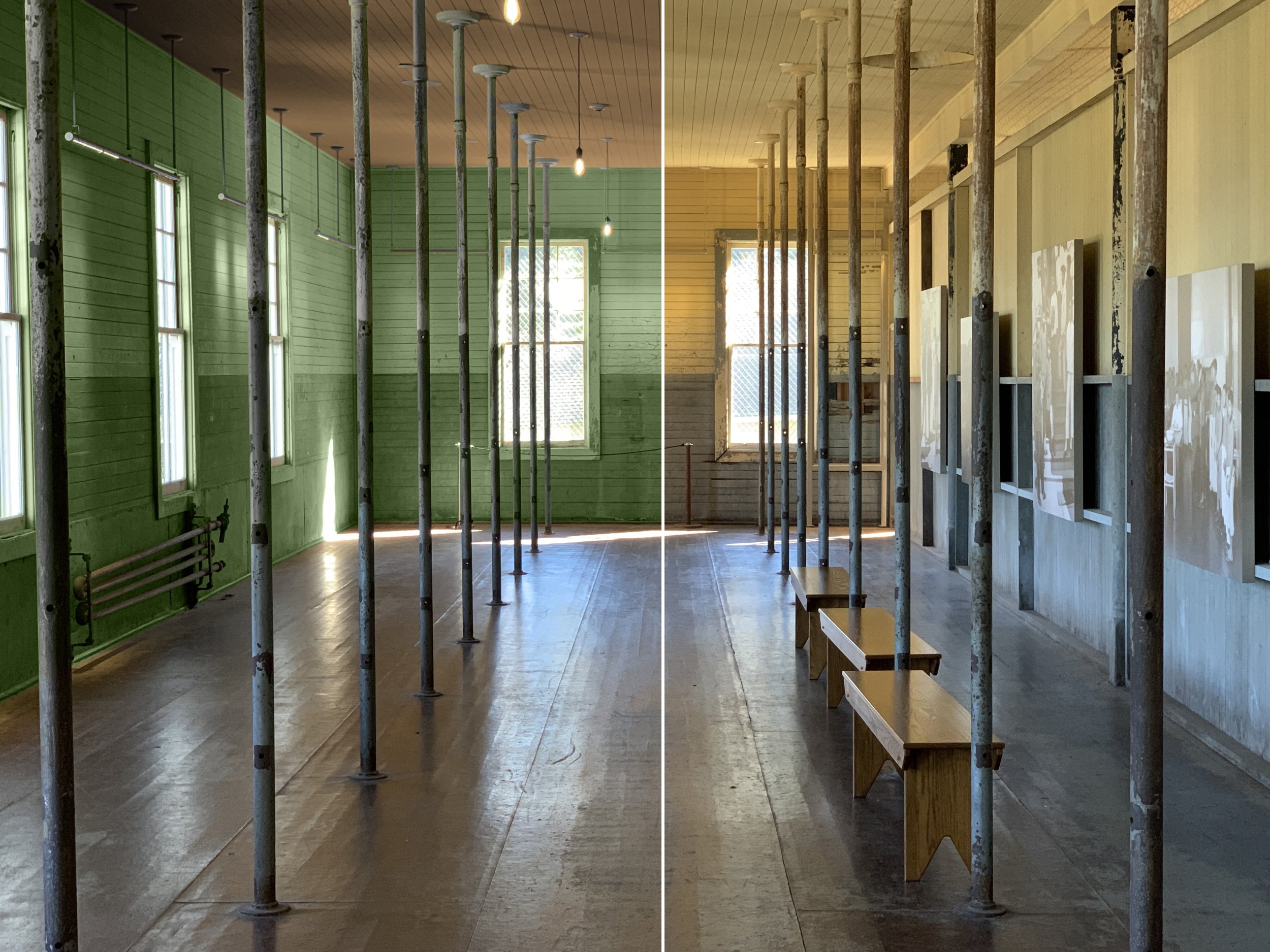Vault #2: The Jade Cage
Revealing the Colors of the Detention Barracks
This digital rendering of how the historic “jade-colored” walls would have appeared (at left). The yellowish paint scheme (at right) shows room 205 today. The barracks’ ceiling was unpainted until the yellowish top coat was applied. Photo credit: AIISF 2020.
In 1910, officials complained about immigrant “graffiti” they discovered in the Chinese barracks. The building’s shiplap walls were made of Douglas fir (a softwood). This material became a suitable canvas for immigrants to express their hopes and frustrations in prose and poetry.
Room 105 was historically used as a Chinese men’s dormitory. Several areas where the wood has been exposed show ink markings from 1910. A medium green paint color is visible in the lower lefthand corner of the image. This color was the first-generation paint used in the building. Photo credit: AIISF, 2022.
The barracks was continually marked with ink and carvings for another sixteen months before the walls were first painted. The first coat applied was a lush green hue. The color was so striking that several immigrants mentioned it in their carved inscriptions.
Untitled Chinese Couplets (Room 111)
Detained in this wooden house for several tens of days,
It is all because of the Mexican exclusion law which implicates me.
It’s a pity heroes have no way of exercising their prowess.
I can only await the word so that I can snap Zu’s whip.
From now on, I am departing far from this building.
All of my fellow villagers are rejoicing with me.
Don’t say that everything within is Western styled.
Even if it is built of jade, it has turned into a cage.
Inscription About a Wooden Building (Room 205)
A building does not have to be tall; if it has windows, it will be bright.
Island is not far, Angel Island.
Alas, this wooden building disrupts my traveling schedule.
Paint on the four walls are green,
And green is the grass which surrounds.
It is noisy because of the many country folk,
And there are watchmen guarding during the night.
To exert influence, one can use a square-holed elder brother.
There are children who disturb the ears,
But there are no incoherent sounds that cause fatigue.
I gaze to the south at the hospital,
And look to the west at the army camp.
This author says, “What happiness is there in this?”
In 2002, conservators studied how many paint layers were applied throughout the building’s history. This image shows the south wall of room 205, where conservators carefully revealed the hidden layers of paint beneath the yellowish top coat. Photo credit: AIISF, 2018.
The jade color would not be the final paint scheme for the barracks. A study found that at least eight paint layers were applied to the walls in the building’s 46-year history. They repainted in 1916 and 1920 and the decades after until the Army gave the building its final yellowish coat during World War II. With each application, inscriptions would be filled in and painted over, leaving little trace of the words left before.
Color Palette of Room 105 (North Wall)
Although the lead-based paint obscured many poems, it also acted as a moisture-resistant sealant, helping preserve the carvings beneath it. Today, over 200 Chinese poems and 300 inscriptions are still visible on the barracks walls. The most recent inscriptions are dated to when the building was used as a prisoner-of-war barracks. They appear as faint pencil writings or soap rubbings, primarily in the Japanese and German languages.
To learn more about the building’s historic inscriptions, click here.
This pencil inscription, dated September (1945), appears on the yellowish paint in room 213. It was left by a military prisoner being repatriated to Japan after the war. The barracks wasn’t repainted after this time, and the site was abandoned by January 1946. Photo credit: AIISF, 2023.
Architectural Resources Group. Angel Island Immigration Detention Barracks "Poems" Study Project #97162.29, Paint Cross-Section Microscopy Report, 2002.
Egan, Charles. Voices of Angel Island: inscriptions and immigrant poetry, 1910-1945. New York: Bloomsbury Academic, 2021.
Lai, H. Mark, Genny Lim, and Judy Yung, eds. Island: Poetry and History of Chinese Immigrants on Angel Island, 1910-1940. Second edition. Seattle: University of Washington Press, 2014.












